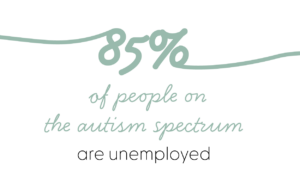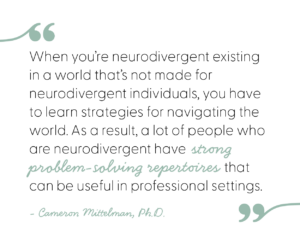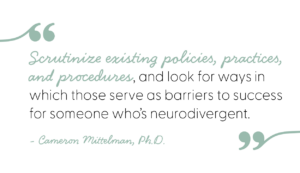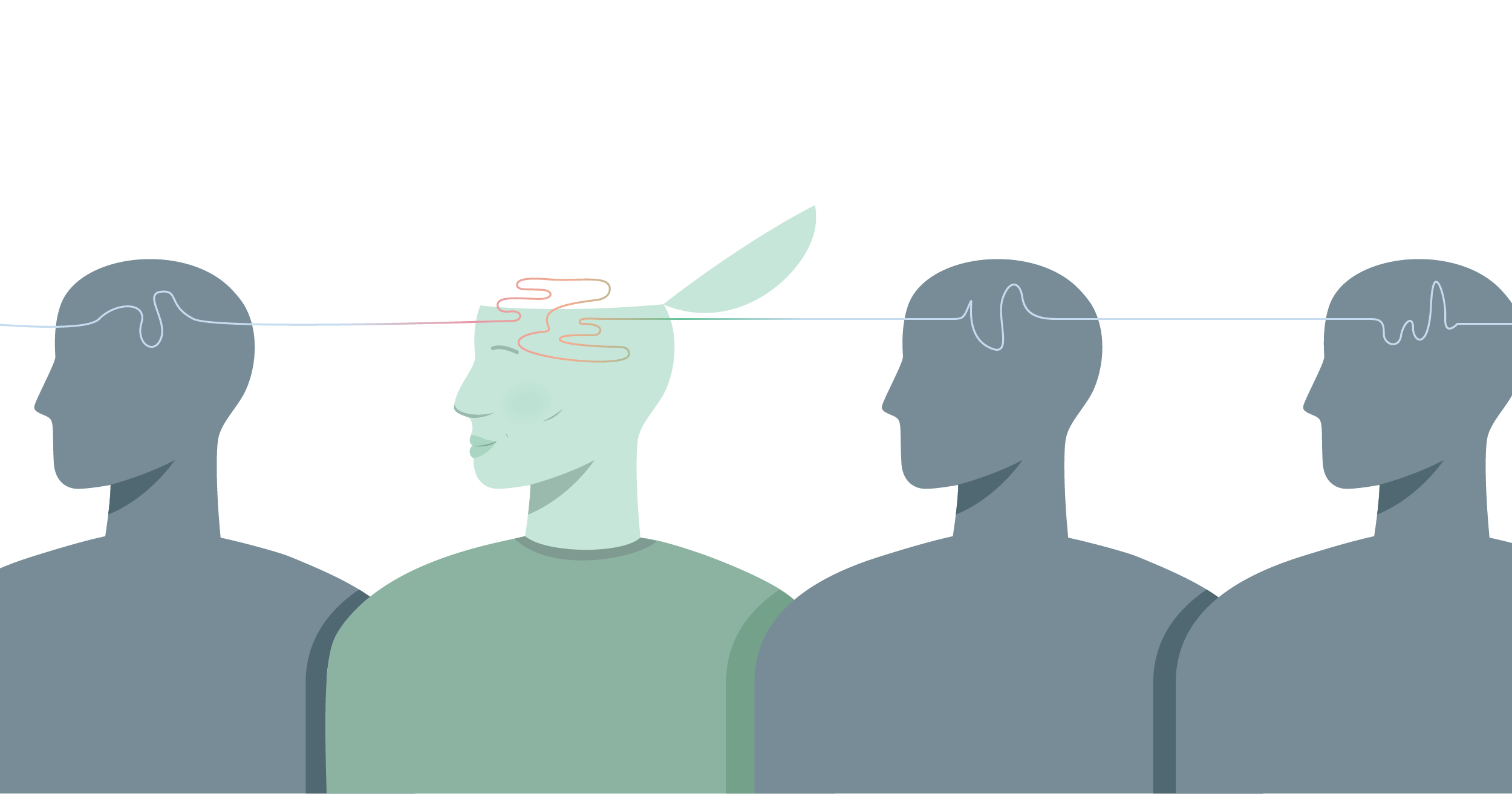Australian sociologist Judy Singer coined the term “neurodiversity” in 1998 when she was writing her undergraduate thesis at the University of Technology, Sydney. In it, she documented a new “disability and social movement” led by and for people with autism.
“‘Neurodiversity’ is a catch-all term that reflects the idea of a diverse population where people process the world around them in different ways,” says clinical neuroscientist, licensed marriage and family therapist, and licensed professional clinical counselor Joshua Wyner, Ph.D., a professor in the Department of Marriage & Family Therapy at The Chicago School.
At the heart of neurodiversity are neurodivergent individuals whose mental functions deviate from what society has deemed “typical.” Usually, neurodivergent individuals have a formal diagnosis that underpins their neurological differences. Often, that’s autism. However, neurodivergence also includes conditions such as ADHD, dyspraxia, dyslexia, Tourette’s syndrome, and obsessive-compulsive disorder (OCD).
“The traditional view of neurological differences is that there’s a ‘normal’ way of being, and that anything outside of that is unusual. Historically, it was believed that it was in everyone’s best interest to correct those neurological differences, and to get anyone who is not neurotypical as close as possible to normality,” says board-certified behavior analyst Cameron Mittelman, Ph.D., a Chicago School alumnus who now chairs the school’s Applied Behavior Analysis program. “What the neurodiversity movement specifically advocates for is the idea that there’s a range of neurology outside of what is considered neurotypical and that we shouldn’t view that as problematic; it’s just something that’s part of who these individuals are.”

It’s a neurotypical world
 Neurodivergent individuals encounter myriad obstacles that can impact their mental, social, and even physical health. Says Dr. Mittelman, “In the United States, at least, society is designed for one particular way of interacting with the world.”
Neurodivergent individuals encounter myriad obstacles that can impact their mental, social, and even physical health. Says Dr. Mittelman, “In the United States, at least, society is designed for one particular way of interacting with the world.”
For example, consider a typical classroom at a typical American school. “We have this notion in education that to be meaningfully engaged, students have to be active participants. That means talking a lot, volunteering answers, and taking in a lot of information very, very quickly,” Dr. Mittelman says. “Those are things that are often very challenging for people who are neurodivergent. If you’re not good at those things, it can make it look like you’re not a good student, or like you’re not paying attention, when in reality it might be that you’re not able to succeed in that particular learning environment because it wasn’t designed with you in mind.”
Because neurodivergent individuals are often labeled lazy, awkward, or irresponsible, even the smallest misunderstandings can compound in significant ways. “A common experience in neurodivergent populations is demoralization,” Dr. Wyner says. “People get tired of being told they’re terrible just because they engage with the world differently. It wears on them.”
From demoralization can come a host of cascading effects with long-lasting consequences. A 2022 study by the University of Cambridge, for example, found “worryingly high rates” of chronic physical and mental health conditions in people who are autistic compared to people who are neurotypical. In 2019, researchers in Australia likewise reported that people with autism are more likely to experience loneliness, which significantly increases a person’s risk of premature death from all causes. Research similarly suggests that neurodivergent students are more likely to be suspended, more likely to be absent and more likely to drop out of school entirely. Meanwhile, consulting firm Deloitte reports that in the United States, “it is estimated that 85% of people on the autism spectrum are unemployed” compared to just 4.2% of the overall population.

Neurodivergence as an asset
 Although neurodivergence is rife with obstacles, neurodiversity can be advantageous. This is especially evident in the workplace, where teams that have neurodivergent professionals in some roles can be 30% more productive than teams that don’t, according to Deloitte, which says inclusion of neurodivergent professionals can boost team morale while fostering diversity of thought, different approaches to work, innovation, and creativity.
Although neurodivergence is rife with obstacles, neurodiversity can be advantageous. This is especially evident in the workplace, where teams that have neurodivergent professionals in some roles can be 30% more productive than teams that don’t, according to Deloitte, which says inclusion of neurodivergent professionals can boost team morale while fostering diversity of thought, different approaches to work, innovation, and creativity.
“When you’re neurodivergent existing in a world that’s not made for neurodivergent individuals, you have to learn strategies for navigating the world. As a result, a lot of people who are neurodivergent have strong problem-solving repertoires that can be useful in professional settings,” Dr. Mittelman says. “Having diversity in experiences can introduce you to new approaches that you otherwise might not have considered. The more neurodiversity we can create, the more unique perspectives we’re going to have.”
Yet it must be said that the neurodiversity movement isn’t about looking for advantage in neurodiversity. Rather, it’s about building acceptance of it.
“Accepting neurodivergent profiles has value simply in the sense that this is the way people exist,” Dr. Mittelman says. “We should look at neurodiversity just on that merit alone.”

Embracing neuro-inclusion
 The neurodiversity movement has legislative and policy goals. For example, the Autism Society of America has called on federal lawmakers to reauthorize and expand the Autism Collaboration, Accountability, Research, Education, and Support (CARES) Act, which funds autism research and services; to pass laws that ensure equitable access to education and employment for neurodivergent individuals; and to fund training for law enforcement and healthcare professionals to help them engage safely and effectively with neurodivergent populations.
The neurodiversity movement has legislative and policy goals. For example, the Autism Society of America has called on federal lawmakers to reauthorize and expand the Autism Collaboration, Accountability, Research, Education, and Support (CARES) Act, which funds autism research and services; to pass laws that ensure equitable access to education and employment for neurodivergent individuals; and to fund training for law enforcement and healthcare professionals to help them engage safely and effectively with neurodivergent populations.
But lawmakers aren’t the only ones who can make the world more accessible to neurodivergent people. Individuals, employers, and institutions also have parts to play.
At the individual level, even small attitude adjustments can make a big difference, according to Dr. Wyner. “Accept the reality that not everybody thinks the way you do,” he says. “Be curious about how others perceive the world instead of assuming their experience is similar to yours.”
Dr. Mittelman concurs. “One of the immediate things everybody can do is to actively listen to people who are neurodivergent,” he says. “People have been advocating for neurodiversity for a long time, so it’s incumbent on you to solicit that information and talk to people who are neurodivergent about their experiences.”
Employers and institutions should take a more systemic approach to neuro-inclusion. “Scrutinize existing policies, practices, and procedures, and look for ways in which those serve as barriers to success for someone who’s neurodivergent,” stresses Dr. Mittelman, who says organizations can improve only by hiring neurodivergent individuals or consultants who can look at the organization through the lens of neurodiversity and make recommendations based on experience rather than assumption.
Potential areas of focus include hiring practices, standard operating procedures, and performance metrics in workplaces; admission requirements, instruction formats, and grading criteria in schools; and everything from sensory environments to communication styles in healthcare, law enforcement and government.
Empathetic instruction
 The Chicago School is leading by example. In its Marriage & Family Therapy program, for example, students have explicit conversations about neurodiversity in their classes, according to Dr. Wyner, who says instructors in his department routinely record lectures to the benefit of neurodivergent students.
The Chicago School is leading by example. In its Marriage & Family Therapy program, for example, students have explicit conversations about neurodiversity in their classes, according to Dr. Wyner, who says instructors in his department routinely record lectures to the benefit of neurodivergent students.
“We started it during COVID, but we’ve tried to maintain it even now that we’re back on campus,” Dr. Wyner says. “Not to allow people to watch instead of coming to class, but because we understand that for a lot of individuals who are neurodivergent, going back and watching class again is actually an incredibly important part of the learning process.”
In his classroom, Dr. Mittelman allows students to put their own spin on the traditional term paper. “In some classes, we’ve changed the assignment such that it doesn’t necessarily have to be in a term-paper format. It can be in the form of a video recording, for example, or an audio recording, There are lots of ways that students can communicate the same information.”
The Chicago School’s commitment to neurodiversity is particularly apparent in the Applied Behavior Analysis program that Dr. Mittelman leads. A discipline that teaches adaptive behaviors to neurodivergent individuals to help them live safer, more successful lives, applied behavior analysis has been controversial in the neurodiversity movement because of the way it was historically practiced, with an intent to cure neurodivergence. The Chicago School takes a different approach.
“In our program, we’ve decided that you don’t have to correct autism, that not every behavior our field has focused on historically warrants behavioral intervention,” says Dr. Mittelman, who says the curriculum teaches clinical practices that are consistent with the principles of the neurodiversity movement. “We’re teaching our students to do things differently.”
Doing things differently is what the neurodiversity movement is all about. “If an individual is so far off the norm that they’re suffering because of it, we can provide support and help, but that’s not the same as eradicating an entire group of people just because they’re different,” Dr. Wyner says. “That’s the most important message for people: It’s OK to think differently. We don’t have to fix that.”

